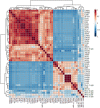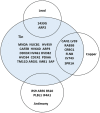Integration of proteomic and metabolomic analyses: New insights for mapping informal workers exposed to potentially toxic elements
- PMID: 36761330
- PMCID: PMC9905639
- DOI: 10.3389/fpubh.2022.899638
Integration of proteomic and metabolomic analyses: New insights for mapping informal workers exposed to potentially toxic elements
Abstract
Occupational exposure to potentially toxic elements (PTEs) is a concerning reality of informal workers engaged in the jewelry production chain that can lead to adverse health effects. In this study, untargeted proteomic and metabolomic analyses were employed to assess the impact of these exposures on informal workers' exposome in Limeira city, São Paulo state, Brazil. PTE levels (Cr, Mn, Ni, Cu, Zn, As, Cd, Sn, Sb, Hg, and Pb) were determined in blood, proteomic analyses were performed for saliva samples (n = 26), and metabolomic analyses in plasma (n = 145) using ultra-high performance liquid chromatography (UHPLC) coupled with quadrupole-time-of-flight (Q-TOF) mass spectrometry. Blood PTE levels of workers, controls, and their family members were determined by inductively coupled plasma-mass spectrometry (ICP-MS). High concentration levels of Sn and Cu were detected in welders' blood (p < 0.001). Statistical analyses were performed using MetaboAnalyst 4.0. The results showed that 26 proteins were upregulated, and 14 proteins downregulated on the welder group, and thirty of these proteins were also correlated with blood Pb, Cu, Sb, and Sn blood levels in the welder group (p < 0.05). Using gene ontology analysis of these 40 proteins revealed the biological processes related to the upregulated proteins were translational initiation, SRP-dependent co-translational protein targeting to membrane, and viral transcription. A Metabolome-Wide Association Study (MWAS) was performed to search for associations between blood metabolites and exposure groups. A pathway enrichment analysis of significant features from the MWAS was then conducted with Mummichog. A total of 73 metabolomic compounds and 40 proteins up or down-regulated in welders were used to perform a multi-omics analysis, disclosing seven metabolic pathways potentially disturbed by the informal work: valine leucine and isoleucine biosynthesis, valine leucine and isoleucine degradation, arginine and proline metabolism, ABC transporters, central carbon metabolism in cancer, arachidonic acid metabolism and cysteine and methionine metabolism. The majority of the proteins found to be statistically up or downregulated in welders also correlated with at least one blood PTE level, providing insights into the biological responses to PTE exposures in the informal work exposure scenario. These findings shed new light on the effects of occupational activity on workers' exposome, underscoring the harmful effects of PTE.
Keywords: exposome; informal work; metabolomics; multi-omics; occupational exposure; potentially toxic elements; proteomics.
Copyright © 2023 Araujo, Leroux, Furtado, Ferreira, Batista, Silva, Handakas, Assunção and Olympio.
Conflict of interest statement
The authors declare that the research was conducted in the absence of any commercial or financial relationships that could be construed as a potential conflict of interest.
Figures


Similar articles
-
Low levels of potentially toxic elements in workers are associated with self-reported health outcomes.Sci Total Environ. 2024 Oct 15;947:174510. doi: 10.1016/j.scitotenv.2024.174510. Epub 2024 Jul 6. Sci Total Environ. 2024. PMID: 38977094
-
Home-based and informal work exposes the families to high levels of potentially toxic elements.Chemosphere. 2019 Mar;218:319-327. doi: 10.1016/j.chemosphere.2018.11.083. Epub 2018 Nov 13. Chemosphere. 2019. PMID: 30476763
-
A Low-Cost Method Shows Potentially Toxic Element Levels in Dust Correlated with Elevated Blood Levels of These Chemicals in Children Exposed to an Informal Home-Based Production Environment.Int J Environ Res Public Health. 2022 Dec 4;19(23):16236. doi: 10.3390/ijerph192316236. Int J Environ Res Public Health. 2022. PMID: 36498308 Free PMC article.
-
Methylomic, Proteomic, and Metabolomic Correlates of Traffic-Related Air Pollution in the Context of Cardiorespiratory Health: A Systematic Review, Pathway Analysis, and Network Analysis.Toxics. 2023 Dec 12;11(12):1014. doi: 10.3390/toxics11121014. Toxics. 2023. PMID: 38133415 Free PMC article. Review.
-
Metabolomic and proteomic applications to exercise biomedicine.Transl Exerc Biomed. 2024 Mar 21;1(1):9-22. doi: 10.1515/teb-2024-2006. eCollection 2024 May. Transl Exerc Biomed. 2024. PMID: 38660119 Free PMC article. Review.
Cited by
-
Introduction to the forensic research via omics markers in environmental health vulnerable areas (FROM) study.Epidemiol Health. 2024;46:e2024062. doi: 10.4178/epih.e2024062. Epub 2024 Jul 12. Epidemiol Health. 2024. PMID: 39026431 Free PMC article.
-
Implementation of multiomic mass spectrometry approaches for the evaluation of human health following environmental exposure.Mol Omics. 2024 Jun 10;20(5):296-321. doi: 10.1039/d3mo00214d. Mol Omics. 2024. PMID: 38623720 Free PMC article. Review.
References
Publication types
MeSH terms
Substances
LinkOut - more resources
Full Text Sources
Research Materials
Miscellaneous

